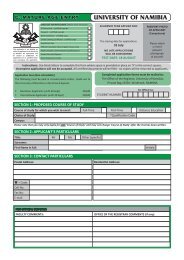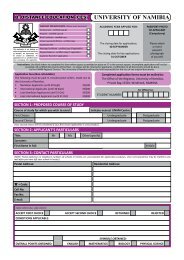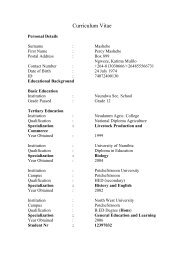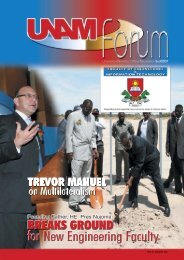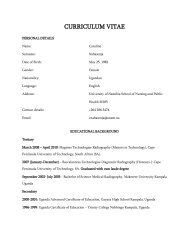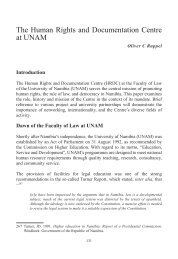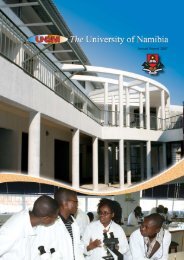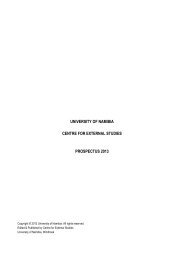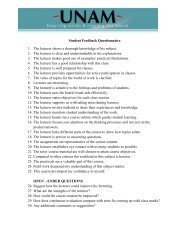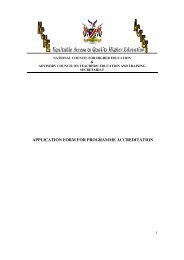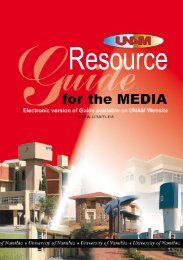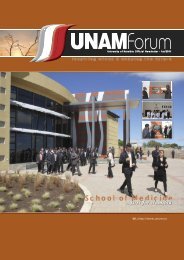Annual Report - University of Namibia
Annual Report - University of Namibia
Annual Report - University of Namibia
- No tags were found...
Create successful ePaper yourself
Turn your PDF publications into a flip-book with our unique Google optimized e-Paper software.
to provide the necessary academicand administrative support to staff andstudents.national development. We are very proudto be among institutions that are trainingfor the future <strong>of</strong> <strong>Namibia</strong>.As the only university and largest teachingpublic institution in the country, the<strong>University</strong> remained under constantpressure to expand access to highereducation. UNAM remained concernedabout the limited number <strong>of</strong> graduatesat school leaving level who obtainedthe required C average to be admittedto undergraduate degree programmes.The Cabinet decision to merge the fourColleges <strong>of</strong> Education with UNAM is,therefore, a step in the right direction toaddress the quality <strong>of</strong> teachers at theelementary and lower primary levels.The establishment <strong>of</strong> the School <strong>of</strong>Medicine has sparked national interestsfrom pupils all over the country includingstudents from high schools who traditionallydid not regard UNAM as their fi rst university<strong>of</strong> choice. A similar trend was also noticedwith the new Faculty <strong>of</strong> Engineeringand Information Technology based atOngwediva in Northern <strong>Namibia</strong>.KEY ACCOMPLISHMENTSThe year under review got <strong>of</strong>f to a roaringstart with the inauguration <strong>of</strong> the Faculty <strong>of</strong>Engineering and Information Technologyat Onwediva by His Excellency Hifi kepunyePohamba, President <strong>of</strong> the Republic <strong>of</strong><strong>Namibia</strong>.All over the southern African region,engineers <strong>of</strong> all types are few and farbetween, yet they play a defi ning role inThe <strong>University</strong> Senate approved thecurriculum <strong>of</strong> the School <strong>of</strong> Medicine, thuslaying the foundation for the country’sfi rst ever School <strong>of</strong> Medicine. This enabledthe <strong>University</strong> to fl ight advertisements invarious media all over the continent andbeyond for staff for the School <strong>of</strong> Medicine.Recruitment <strong>of</strong> key staff members <strong>of</strong> theschool was done during this period.The <strong>University</strong> had a total staff complement<strong>of</strong> 815 during 2009. This fi gure includes 419academic staff, 259 academic supportstaff and 137 central administrative staff.Expatriate staff accounted for only 17% <strong>of</strong>all academic staff, while females made up47% <strong>of</strong> the total number <strong>of</strong> <strong>University</strong> staff.In a foresighted effort to create adequateacademic human capacity for thenational university and to engenderhuman resources development capable<strong>of</strong> addressing the defi cit <strong>of</strong> the pastand spearheading socioeconomicdevelopment agenda in the country,the Council <strong>of</strong> the <strong>University</strong> <strong>of</strong> <strong>Namibia</strong>established a Staff DevelopmentCommittee. UNAM has therefore mountedan aggressive staff developmentprogramme to build the local capacity<strong>of</strong> both its academic and administrativestaff. During 2009, 87 members <strong>of</strong> staffwere pursuing Doctoral degrees, 29 wereenrolled for Masters Degrees while 21 andnine others were enrolled for Bachelor’sand other qualifi cations respectively atUniversities in the region and abroad.<strong>Annual</strong> <strong>Report</strong> 2009 -5-



